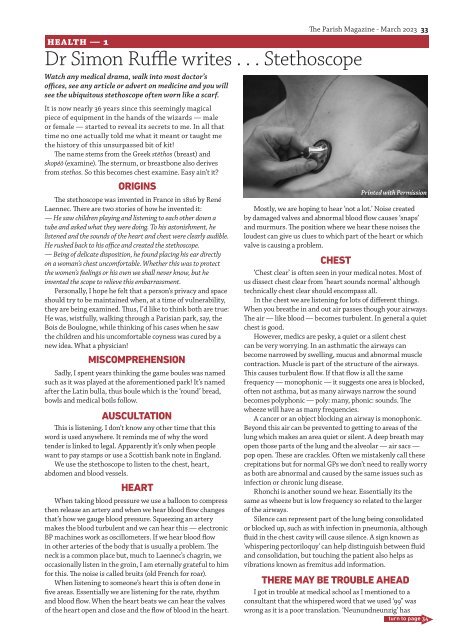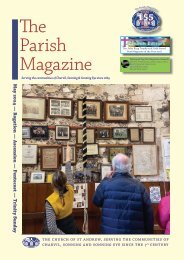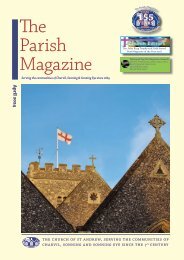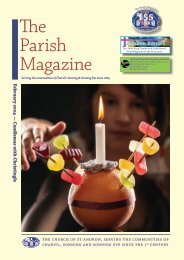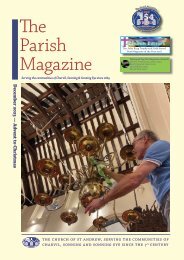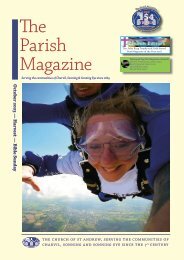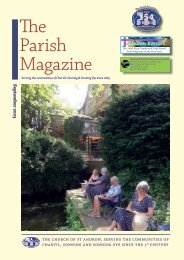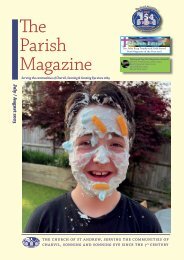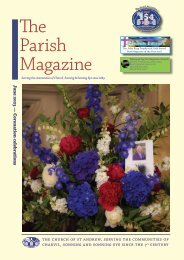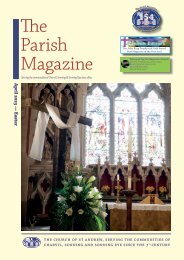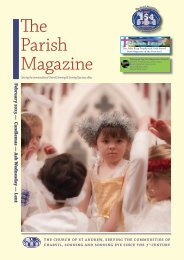The Parish Magazine March 2023
Serving the communities of Charvil, Sonning and Sonning Eye since 1869
Serving the communities of Charvil, Sonning and Sonning Eye since 1869
Create successful ePaper yourself
Turn your PDF publications into a flip-book with our unique Google optimized e-Paper software.
HEALTH — 1<br />
Dr Simon Ruffle writes . . . Stethoscope<br />
Watch any medical drama, walk into most doctor’s<br />
offices, see any article or advert on medicine and you will<br />
see the ubiquitous stethoscope often worn like a scarf.<br />
It is now nearly 36 years since this seemingly magical<br />
piece of equipment in the hands of the wizards — male<br />
or female — started to reveal its secrets to me. In all that<br />
time no one actually told me what it meant or taught me<br />
the history of this unsurpassed bit of kit!<br />
<strong>The</strong> name stems from the Greek stēthos (breast) and<br />
skopéō (examine). <strong>The</strong> sternum, or breastbone also derives<br />
from stethos. So this becomes chest examine. Easy ain’t it?<br />
ORIGINS<br />
<strong>The</strong> stethoscope was invented in France in 1816 by René<br />
Laennec. <strong>The</strong>re are two stories of how he invented it:<br />
— He saw children playing and listening to each other down a<br />
tube and asked what they were doing. To his astonishment, he<br />
listened and the sounds of the heart and chest were clearly audible.<br />
He rushed back to his office and created the stethoscope.<br />
— Being of delicate disposition, he found placing his ear directly<br />
on a woman’s chest uncomfortable. Whether this was to protect<br />
the women’s feelings or his own we shall never know, but he<br />
invented the scope to relieve this embarrassment.<br />
Personally, I hope he felt that a person’s privacy and space<br />
should try to be maintained when, at a time of vulnerability,<br />
they are being examined. Thus, I’d like to think both are true:<br />
He was, wistfully, walking through a Parisian park, say, the<br />
Bois de Boulogne, while thinking of his cases when he saw<br />
the children and his uncomfortable coyness was cured by a<br />
new idea. What a physician!<br />
MISCOMPREHENSION<br />
Sadly, I spent years thinking the game boules was named<br />
such as it was played at the aforementioned park! It’s named<br />
after the Latin bulla, thus boule which is the ‘round’ bread,<br />
bowls and medical boils follow.<br />
AUSCULTATION<br />
This is listening. I don’t know any other time that this<br />
word is used anywhere. It reminds me of why the word<br />
tender is linked to legal. Apparently it’s only when people<br />
want to pay stamps or use a Scottish bank note in England.<br />
We use the stethoscope to listen to the chest, heart,<br />
abdomen and blood vessels.<br />
HEART<br />
When taking blood pressure we use a balloon to compress<br />
then release an artery and when we hear blood flow changes<br />
that’s how we gauge blood pressure. Squeezing an artery<br />
makes the blood turbulent and we can hear this — electronic<br />
BP machines work as oscillometers. If we hear blood flow<br />
in other arteries of the body that is usually a problem. <strong>The</strong><br />
neck is a common place but, much to Laennec’s chagrin, we<br />
occasionally listen in the groin, I am eternally grateful to him<br />
for this. <strong>The</strong> noise is called bruits (old French for roar).<br />
When listening to someone’s heart this is often done in<br />
five areas. Essentially we are listening for the rate, rhythm<br />
and blood flow. When the heart beats we can hear the valves<br />
of the heart open and close and the flow of blood in the heart.<br />
<strong>The</strong> <strong>Parish</strong> <strong>Magazine</strong> - <strong>March</strong> <strong>2023</strong> 33<br />
Printed with Permission<br />
Mostly, we are hoping to hear ‘not a lot.’ Noise created<br />
by damaged valves and abnormal blood flow causes ‘snaps’<br />
and murmurs. <strong>The</strong> position where we hear these noises the<br />
loudest can give us clues to which part of the heart or which<br />
valve is causing a problem.<br />
CHEST<br />
‘Chest clear’ is often seen in your medical notes. Most of<br />
us dissect chest clear from ‘heart sounds normal’ although<br />
technically chest clear should encompass all.<br />
In the chest we are listening for lots of different things.<br />
When you breathe in and out air passes though your airways.<br />
<strong>The</strong> air — like blood — becomes turbulent. In general a quiet<br />
chest is good.<br />
However, medics are pesky, a quiet or a silent chest<br />
can be very worrying. In an asthmatic the airways can<br />
become narrowed by swelling, mucus and abnormal muscle<br />
contraction. Muscle is part of the structure of the airways.<br />
This causes turbulent flow. If that flow is all the same<br />
frequency — monophonic — it suggests one area is blocked,<br />
often not asthma, but as many airways narrow the sound<br />
becomes polyphonic — poly: many, phonic: sounds. <strong>The</strong><br />
wheeze will have as many frequencies.<br />
A cancer or an object blocking an airway is monophonic.<br />
Beyond this air can be prevented to getting to areas of the<br />
lung which makes an area quiet or silent. A deep breath may<br />
open those parts of the lung and the alveolar — air sacs —<br />
pop open. <strong>The</strong>se are crackles. Often we mistakenly call these<br />
crepitations but for normal GPs we don’t need to really worry<br />
as both are abnormal and caused by the same issues such as<br />
infection or chronic lung disease.<br />
Rhonchi is another sound we hear. Essentially its the<br />
same as wheeze but is low frequency so related to the larger<br />
of the airways.<br />
Silence can represent part of the lung being consolidated<br />
or blocked up, such as with infection in pneumonia, although<br />
fluid in the chest cavity will cause silence. A sign known as<br />
'whispering pectoriloquy' can help distinguish between fluid<br />
and consolidation, but touching the patient also helps as<br />
vibrations known as fremitus add information.<br />
THERE MAY BE TROUBLE AHEAD<br />
I got in trouble at medical school as I mentioned to a<br />
consultant that the whispered word that we used ‘99'' was<br />
wrong as it is a poor translation. ‘Neunundneunzig’ has<br />
turn to page 34


